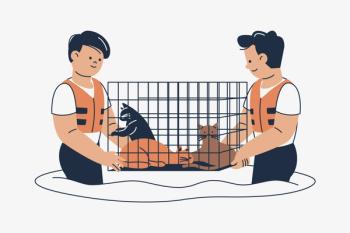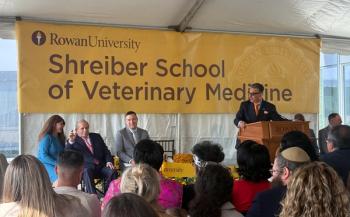
The Triennial Report: Stop treatment point dips as veterinarians remain concerned about economy
National Report - Pet owners are throwing in the towel earlier on veterinary treatment, according to a new DVM Newsmagazine survey.
Editor's Note: DVM Newsmagazine's State of the Profession survey is conducted every three years to examine the trends shaping veterinary practice and education. Over the next three months, the magazine will report on key findings from the survey.Log on to
National Report — Pet owners are throwing in the towel earlier on veterinary treatment, according to a new DVM Newsmagazine survey.
Table 1
Veterinarians were asked in January to estimate the average dollar amount most clients spend before they opt to stop treatment of a sick or injured animal.
The number: $1,407. That's down from an average of $1,451 in 2006, representing a 3 percent decline over the three-year period. (See Methodology, p. 21).
The wide-ranging survey findings, which will be reported over the next few months, tell a tale of two very different practice types, largely based on size.
In veterinary practices grossing more than $1.7 million, the stop-treatment point swelled to an average of $2,043, compared to just $1,359 for practices grossing between $250,000 and $499,000.
Examining the stop-treatment point offers insight from veterinarians about the human-animal bond and the economic end point of a client's willingness to continue treatment.
In contrast, the American Veterinary Medical Association (AVMA) reports that most pet owners spend just $356 a year in a $24.5 billion veterinary-services market.
The survey, conducted amid the downward-spiraling economy, shows pessimism, compared to past results.
A look at the numbers
The most pressing issue facing veterinary medicine is rising costs, according to 59 percent of respondents (Table 2). That trumped employee retention (9 percent), competition (4 percent), specialization (4 percent) and government oversight (4 percent). Both male and female veterinarians shared the concern, with 64 percent of female DVMs citing escalating costs as the most serious issue facing the profession.
Table 2
In 2009, 61 percent of veterinarians say their local economy has negatively influenced practice revenue. Only 8 percent report the influence was positive (Table 1).
Table 3
In addition, an anemic 31 percent predict that practice revenue will increase for 2009. However, 43 percent believe it will stay about the same, while about 26 percent believe revenue will decline (Table 4).
When these data were cross-tabulated by practice size, veterinary practices grossing between $1.25 million and $1.75 million reported the weakest growth.
Table 4
In fact, 32 percent of practices grossing $1.5 million to $1.7 million say that revenue from 2008 was down from 2007. About 28 percent of them said it was about the same and 40 percent reported revenue growth.
Table 5
In comparison, 57 percent of practices in the $750,000 to $1 million gross-revenue category said their revenues were up. Historically, these practice segments have posted the most growth. For example, in 2005, 86 percent of practices reported gross revenue increases over the year prior.
Table 6
Revenue mix
In general, veterinarians believe they will be more reliant on diagnostics and a little less on product sales. The revenue categories expected to grow are diagnostics, annual exams, surgery and non-invasive medical procedures. Revenue categories likely to decline are vaccinations and product sales (Table 6).
Table 7
In contrast, mark-ups are expected to remain about the same in key product categories in 2009. Vaccines/biologicals have seen a steady drop since 1997. So have heartworm preventives and flea-control products. Modest mark-ups of pet foods are noted since 2003 (Table 7, p. 21).
Despite the recession jitters, veterinarians remain bullish about the future. In fact, 59 percent of them believe their practice gross will increase over the next three years — by about 3.5 percent annually, on average (Table 5).
But their confidence about the economic picture has been shaken from previous surveys. When asked in 2006 about the prospects for the next three years, 85 percent said they anticipated growth.
Methodology
This year, one third of practices believe revenue will be flat, and 14 percent are bracing for a dip in gross earnings (Table 5).
Staffing
Some 53 percent of respondents report no new positions were created last year, while 29 percent report one job added to their practice. On average, practices replaced three employees from existing positions last year. The average length of employment for veterinary technicians was 5.7 years, the survey says.
The survey asked whether practices had plans to hire additional veterinarians in 2009. Some 64 percent said no, while 36 percent said they planned to hire one or more. In 2006, 51 percent planned to hire one or more DVMs.
Brighter outlook?
In 2006, nearly three-quarters of veterinarians responding to the survey predicted revenue increases for the following year.
In 2009, this group of optimists shrunk to just 31 percent of the respondent base (Table 4, p. 19).
If flat is the new earnings benchmark for this recession, then there's reason to celebrate. About 74 percent believe practice revenue either will increase or stay the same as last year. Nearly half of those survey respondents say this year's revenue will "stay about the same." Only 24 percent of the respondents in 2006 predicted flat growth for the year.
As part of the survey, veterinarians were asked to describe their practice philosophy.
Sixty-seven percent said they accept all paying clients, providing them with whatever level of service they request/require. In 2006, 64 percent said that.
Likewise, one-quarter of the respondents said they "offer primarily high-quality diagnostic medicine and surgery, and tend to have clients for whom cost of treatment is not a major factor."
In 2006, 31 percent were in that group, representing a 6 percent decline in the three years since. Additionally, the number of practices "offering basic medical services, pricing it low to attract cost-conscious pet owners" jumped to 8 percent in 2009 from 5 percent in 2006.
The numbers of patients seen in an average week decreased slightly from past surveys. In 2009, veterinarians reported seeing an average of 66 patients a week (13 a day), down from a high of 76 in 2000.
The most significant decline was noted for those veterinarians in solo practices. In 1997, they saw 82 patients a week on average, but that number dropped to 63 in 2009.
The mean average client transaction (ACT) amounted to $108, up only $2 from 2006. ACT amounts increased by practice size on average. Almost 60 percent of four-plus DVM practices averaged more than $120, while nearly 31 percent of solo practitioners were between $70 and $99 (Table 5, p. 19).
Most practitioners reported that their ACTs have increased "a little."
Newsletter
From exam room tips to practice management insights, get trusted veterinary news delivered straight to your inbox—subscribe to dvm360.




